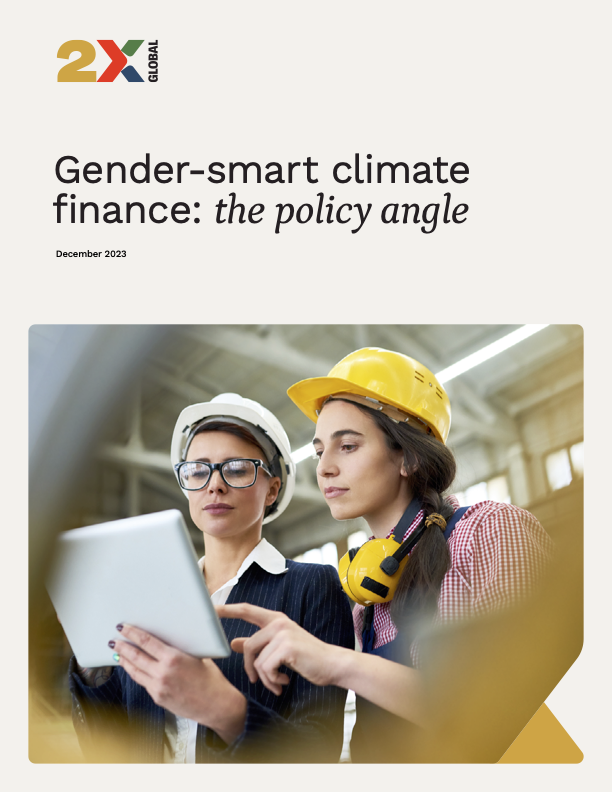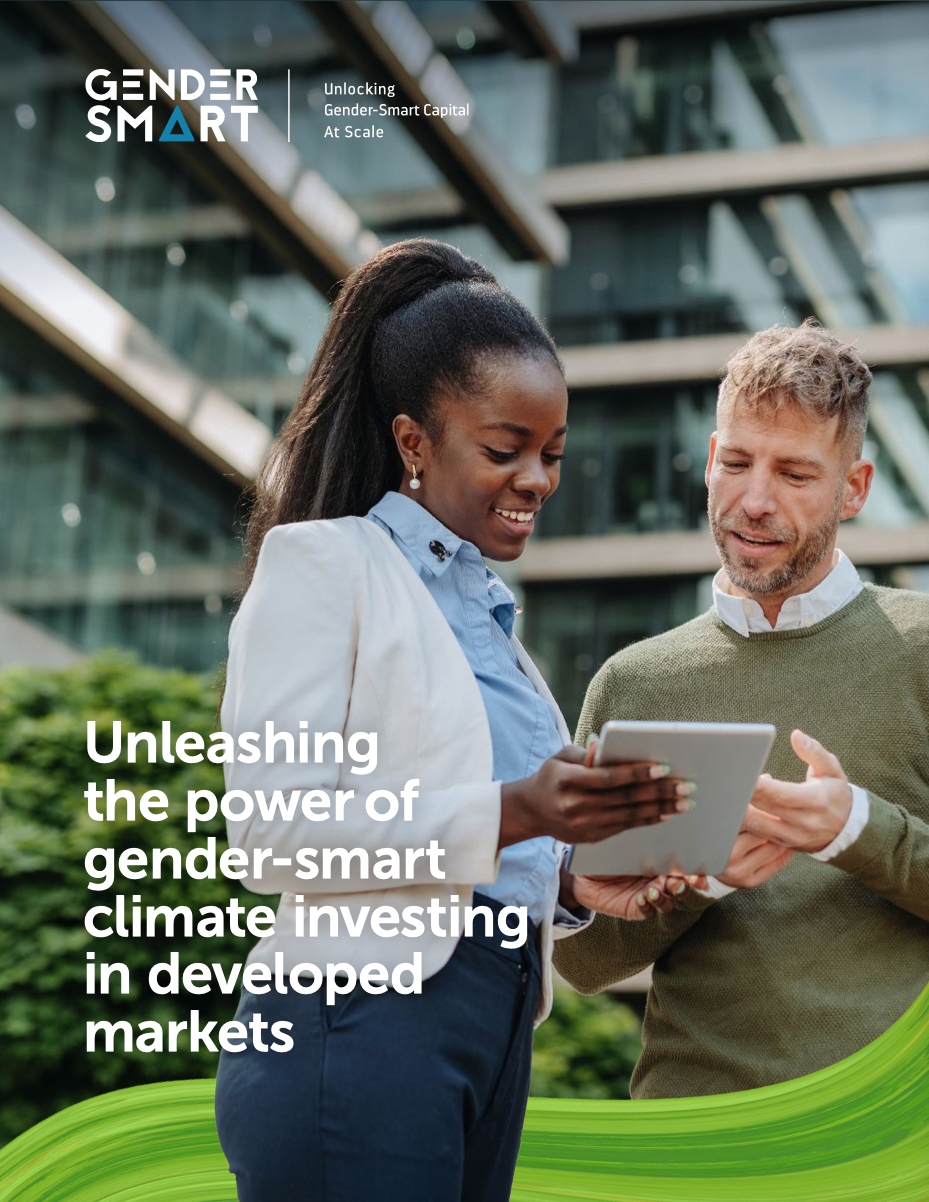Project Catalyst
This report serves as a snapshot of the activity of gender lens funds in private markets. It is aimed primarily at fund managers, Limited Partners, ecosystem builders, and researchers who are actively engaged in the field of gender lens investing or who are interested in better understanding the field. While the report captures a broad set of information about 175 gender lens funds, representing the work of 126 fund managers from around the globe, it is important to acknowledge that an even broader context exists. There are segments within the gender finance ecosystem that are not captured because the investors did not report data nor publicise their gender-focused initiatives. Additionally, this report focuses on activity in private markets only. There are also gender lens equity and debt funds, gender bonds, and other securities that are trading in public markets.
Gender-smart climate finance: the policy angle
This report explores the connection between gender and climate finance, focusing on the importance of gender-smart investments in the broader climate finance and policy arena. The analysis presented in this report highlights why a gender lens matters for climate finance and outlines key points to inform discussions and deliberations during seminal policy discussions, covering COP29, other regional climate events, the New Collective Quantified Goal on Climate Finance (NCQG) Technical Expert Discussions (TEDs) on global climate finance goals beyond 2025 and more.
Addressing gender-based violence and harassment (GBVH) at the intersection of climate and gender finance
As the finance field increases in maturity, more investors are deepening their approaches and enhancing the rigour of their gender analysis by integrating considerations around gender-based violence and harassment (GBVH).
This brief illustrates how gender-smart investors can integrate considerations around GBVH into their climate and gender finance strategies.
Envisioning Fair Futures
Investments reflect our belief in the future. As investors, we deploy capital to assets and activities that they believe will generate returns over time. We have the power to choose where, how our capital is allocated. What if we can utilise this power to actively shape the future in which our investments happen?
Report on the Workshop on Gender-Responsive Indicators and Performance Measurement with Relevance for the Green Climate Fund (GCF) and other Climate Funds
From Heinrich Böll Stiftung - Objective: To develop and strategize on recommending possible gender indicators, as well as gender-responsive sector indicators, for climate-relevant funding contexts, such as the Performance Measurement Frameworks (PMF) for the GCF.
The workshop was structured around an introductory presentation on the status of GCF and specifically PMF operationalization, given by Anna Williams, a specialist consulting on monitoring and evaluation with the GCF Secretariat. This was followed by short descriptions of lessons learned and challenges experienced with respect to the integration of gender considerations in the Climate Investments Funds (CIFs), the climate instruments under the Global Environment Facility (GEF) and the Adaptation Fund. Gender and sector experts discussed then in small groups possible improvements to the existing GCF PMFs, focusing on the indicators still to be decided. A concluding feedback session in the plenary then collected and discussed small group proposals and formulated some key recommendations. It is expected that these will provide useful suggestions for the finalization of the GCF PMFs, to be decided either at the upcoming 10th or 11th GCF Board meetings later this year.
Gender Responsive Indicators - Gender and NDC Planning for Implementation
From UNDP - Gender responsiveness refers to outcomes that reflect an understanding of gender roles and inequalities and encourage equal participation, including equal and fair distribution of benefits. Gender responsiveness is accomplished through gender analysis, that informs inclusiveness. Often, we must try to support efforts that transform unequal gender relations to promote shared power, control of resources, decision-making, and support for women’s empowerment.
This reports details how to design these activities for sectoral actions in climate initiatives, which then encourages equal participation, and fair distribution of benefits.
Mainstreaming gender in environment statistics for the SDGs and beyond: Identifying priorities in Asia and the Pacific
From United Nations - Just as women and men have unequal access to rights, resources and opportunities, they relate to and interact with the natural environment in different ways, face differing vulnerabilities and impacts, and have unique adaptive capacity related to climate change, disasters and use of natural resources. The nexus between gender and environment has been of interest for decades, with the 2030 Agenda for Sustainable Development providing renewed impetus to the discussion. The Agenda calls for a better and sustainable future for all, making it implicit development cannot progress without addressing inequality, discrimination and exclusion affecting women and men in all spheres, including in relation to the environment. However, the links between gender and environment are not well understood and gaps in data availability impede progress assessment. Regional level follow-up and review form an integral part of the overall accountability framework for the 2030 Agenda.
This paper provides an overview of recent initiatives to measure the gender-environment nexus, identifies priorities and takes stock of related data and capacity gaps in the Asia-Pacific region. The paper puts forward a proposal for a Gender-Environment Indicator Set in Asia and the Pacific, which includes indicators from the global Sustainable Development Goals framework and beyond, capturing issues of particular relevance for the gender-environment nexus in the region.
The Climate Action Gender Gap
From Oliver Wyman Forum - More than a fifth of major corporations have pledged to reach net-zero emissions by 2050. Yet few actively include or consider women in their climate action decisions and plans. This is a mistake. Research shows that women are the most likely change‑makers for climate in economic areas from corporate leadership to product development. But these potential contributions are generally overlooked, we discovered in interviews with more than 20 companies across a range of industries. These challenges should be linked together, especially given the similarities in their requirements for tangible impact: committed leadership, a rigorous focus on data, and continuous learning across the organization. Our conversations and research uncovered opportunities for corporations to speed up the world’s race to net zero by mainstreaming gender considerations in climate focused business initiatives — in particular, by actively considering women in three roles: Climate action leaders; Climate-lens investors; Low-carbon product influencers.
Gender-Smart Investing Resource Hub
From ICRW - Learn how to better integrate gender into investment processes to make smarter investments that enhance returns, gender equality and women’s economic empowerment.
WEDO - Discussion Paper: Gender Equality and Just Transition
From WEDO - Summary: A gender just transition must further take into account the role of women’s unpaid care work, particularly in developing countries, as well as women’s informal work, both of which in essence subsidize our current economic systems and are financially unrecognized or undervalued. The precariousness of women’s work is compounded by current trends such as seasonal and forced migration, the feminization of agricultural labor, the lack of formal recognition for women as farmers, the lack of health protections in the informal sector, the transportation of women in Qatar and the Arab peninsula, among others. Women entrepreneurs are also disproportionately represented in small enterprises, which have less access to credit and loans, and in the micro and small informal sector. As feminists in the labor movement denounce, while working conditions in general are poor in many industries, they are often worse for women.
W+ Standard White Paper - Carbon Markets and Gender Equality
From WOCAN and the W+ Advisory Council - This white paper posits that if we don’t address gender and climate jointly, we undermine both agendas. By integrating the two, we can amplify the impact of both. The cost of inaction is high. To reach the scale required for fast climate results, we cannot afford to exclude the knowledge, skills and networks of women by neglecting their contributions to tackle climate change, nor ignore the threats climate change poses to global gains in advancing gender equality and women’s empowerment.
Mainstreaming Gender in Green Climate Fund Projects
From Green Climate Fund (GCF) - This manual addresses GCF’s potential to mainstream gender into climate finance, building on its mandate to support a paradigm shift to low-emission and climate-resilient development. Developed with UN Women, this toolkit guides GCF partners on how to include women, girls, men, and boys from socially excluded and vulnerable communities in all aspects of climate finance.
ADB - Gender & Climate Finance Policy Brief
From Asian Development Bank - The paper highlights the need and demand for mitigation measures that tap women’s potential to contribute to emissions reductions and sustainable development.
Building Gender into Climate Finance: ADB Experience with the Climate Investment Funds
From Asian Development Bank - This publication confirms the shared commitment of ADB and the Climate Investment Funds (CIF) to mainstreaming gender equality in climate change and showcases how this priority is being integrated into the design of ADB’s CIF projects.
Inclusive gender and climate finance
Investing at the nexus of gender and climate finance has been evolving in recent years: from the development of new research and case studies that help make the case for this approach and illustrate its benefits, to the emergence of tools to support investors in adopting an integrated approach. Yet few of these examples and tools have engaged intentionally with the full breadth of intersections between climate action, gender and a broader inclusive and JEDI lens in the investment community. This guide is designed to help investors and investment intermediaries do just that.
Applying a Gender Lens to Climate Investing: An Action Framework
This Framework, developed by the Women in Finance Climate Action Group in partnership with Oliver Wyman, 2X Global and the 30% Club, is designed to help financial institutions to embed gender considerations into their climate investment decisions, to both mitigate the disproportionate impact of climate change on women and support women as change makers in the net zero transition. It is designed specifically for private institutional investors given the key role the play in financing the net zero transition. The framework provides practical guidance on target outcomes, key organisation and investment process changes, and metrics for gender-smart climate investing.
Unleashing the power of gender-smart climate investing in developed markets
In the last few years, investors have begun to recognise the vast financial risks that climate change poses. Few investors, however, fully recognise the potential from integrating gender and climate lenses together in investments for long-term climate solutions. The following case studies illustrate the ‘what, why, why now and how’ of gender and climate investing in developed markets, and the opportunities that can arise from integrating both lenses
Diversity drives climate action in the boardroom
From Moxie Future: This study provides clear data that a more diverse boardroom leads ot bolder measures in addressing climate change after studying 159 global firms, some of which are the world’s biggest carbon emitting companies.
Integrating gender considerations into sustainable bonds
This How-To-Guide on integrating gender into sustainable bonds outlines the opportunity to bring gender considerations into all sustainable bond issuances and takes the reader through a step-by-step approach to integrating gender in green bonds and sustainability-linked bonds.
2X Climate Finance Task Force Toolkit: The Gender-Smart Climate Finance Guide
From the 2X Collaborative. A toolkit enabling investors to identify opportunities and mitigate risks in gender and climate finance. This Toolkit explains how investors and fund managers can identify and prioritise gender-smart climate investments, as well as related risks and opportunities. They can do so by applying a gender-smart lens to their climate finance qualified investments. Both direct investments and indirect investments in financial intermediaries (including a percentage of a financial institution’s on-lending facilities or a percentage of a fund manager’s portfolio) may qualify.








